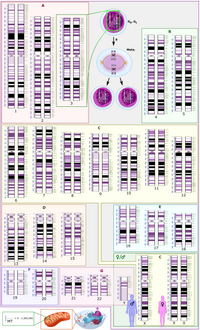
Programmed ubiquitin acetylation using genetic code expansion reveals altered ubiquitination patterns
Sign Up to like & getrecommendations! Published in 2019 at "FEBS Letters"
DOI: 10.1002/1873-3468.13702
Abstract: Ubiquitination is a post‐translational modification (PTM) capable of being regulated by other PTMs, including acetylation. However, the biological consequences of acetylated ubiquitin (acUb) variants are poorly understood, due to their transient nature in vivo and… read more here.
Keywords: code expansion; acetylation; ubiquitination patterns; using genetic ... See more keywords

Expanding the Genetic Code for Neuronal Studies
Sign Up to like & getrecommendations! Published in 2020 at "Chembiochem"
DOI: 10.1002/cbic.202000300
Abstract: Genetic code expansion is one of the most powerful technologies in protein engineering. In addition to the 20 canonical amino acids, the expanded genetic code is supplemented by unnatural amino acids, which have artificial side… read more here.
Keywords: code expansion; amino acids; code; code neuronal ... See more keywords

Genetic code expansion via integration of redundant amino acid assignment by finely tuning tRNA pools.
Sign Up to like & getrecommendations! Published in 2018 at "Current opinion in chemical biology"
DOI: 10.1016/j.cbpa.2018.07.010
Abstract: In all translation systems, the genetic code assigns codons to amino acids as building blocks of polypeptides, defining their chemical, structural and physiological properties. The canonical genetic code, however, utilizes only 20 proteinogenic amino acids… read more here.
Keywords: code expansion; amino acids; code; expansion via ... See more keywords

New opportunities for genetic code expansion in synthetic yeast.
Sign Up to like & getrecommendations! Published in 2022 at "Current opinion in biotechnology"
DOI: 10.1016/j.copbio.2022.102691
Abstract: The synthetic yeast, Sc2.0, is nearing completion as consolidation of all 17 synthetic chromosomes into a single cell advances. This organism will be the first synthetic eukaryote and provides a highly plastic biological chassis built… read more here.
Keywords: code expansion; yeast; synthetic yeast; genetic code ... See more keywords

Engineering translation components for genetic code expansion.
Sign Up to like & getrecommendations! Published in 2021 at "Journal of molecular biology"
DOI: 10.1016/j.jmb.2021.167302
Abstract: The expansion of the genetic code consisting of four bases and 20 amino acids into diverse building blocks has been an exciting topic in synthetic biology. Many biochemical components are involved in gene expression; therefore,… read more here.
Keywords: code expansion; engineering; code; biology ... See more keywords

Deciphering the Interactome of Histone Marks in Living Cells via Genetic Code Expansion Combined with Proximity Labeling.
Sign Up to like & getrecommendations! Published in 2022 at "Analytical chemistry"
DOI: 10.1021/acs.analchem.2c01042
Abstract: Deciphering the endogenous interactors of histone post-translational modifications (hPTMs, also called histone marks) is essential to understand the mechanisms of epigenetic regulation. However, most of the analytical methods to determine hPTM interactomes are in vitro… read more here.
Keywords: histone marks; histone; genetic code; code expansion ... See more keywords

Genetic Code Expansion: Inception, Development, Commercialization.
Sign Up to like & getrecommendations! Published in 2021 at "Journal of the American Chemical Society"
DOI: 10.1021/jacs.0c11938
Abstract: Virtually all natural proteins are built from only 20 amino acids, and while this makes possible all the functions they perform, the ability to encode other amino acids selected for specific purposes promises to enable… read more here.
Keywords: expansion inception; commercialization; genetic code; code expansion ... See more keywords

An orthogonalized platform for genetic code expansion in both bacteria and eukaryotes.
Sign Up to like & getrecommendations! Published in 2017 at "Nature chemical biology"
DOI: 10.1038/nchembio.2312
Abstract: In this study, we demonstrate the feasibility of expanding the genetic code of Escherichia coli using its own tryptophanyl-tRNA synthetase and tRNA (TrpRS-tRNATrp) pair. This was made possible by first functionally replacing this endogenous pair… read more here.
Keywords: trprs trnatrp; code expansion; platform genetic; code ... See more keywords

Site-specific ubiquitylation and SUMOylation using genetic-code expansion and sortase
Sign Up to like & getrecommendations! Published in 2019 at "Nature Chemical Biology"
DOI: 10.1038/s41589-019-0227-4
Abstract: Post-translational modification of proteins with ubiquitin and ubiquitin-like proteins (Ubls) is central to the regulation of eukaryotic cellular processes. Our ability to study the effects of ubiquitylation, however, is limited by the difficulty to prepare… read more here.
Keywords: code expansion; site specific; ubiquitylation; sortase ... See more keywords

Switchable genome editing via genetic code expansion
Sign Up to like & getrecommendations! Published in 2018 at "Scientific Reports"
DOI: 10.1038/s41598-018-28178-3
Abstract: Multiple applications of genome editing by CRISPR-Cas9 necessitate stringent regulation and Cas9 variants have accordingly been generated whose activity responds to small ligands, temperature or light. However, these approaches are often impracticable, for example in… read more here.
Keywords: genetic code; genome editing; code expansion; cas9 ... See more keywords

Update of the Pyrrolysyl-tRNA Synthetase/tRNAPyl Pair and Derivatives for Genetic Code Expansion
Sign Up to like & getrecommendations! Published in 2023 at "Journal of Bacteriology"
DOI: 10.1128/jb.00385-22
Abstract: The cotranslational incorporation of pyrrolysine (Pyl), the 22nd proteinogenic amino acid, into proteins in response to the UAG stop codon represents an outstanding example of natural genetic code expansion. Genetic encoding of Pyl is conducted… read more here.
Keywords: genetic code; code expansion; trnapyl; pylrs ... See more keywords